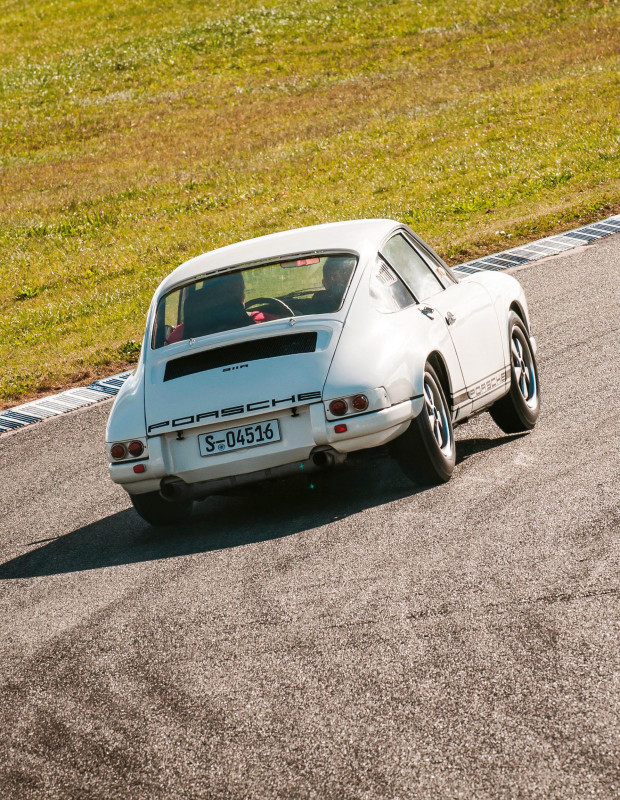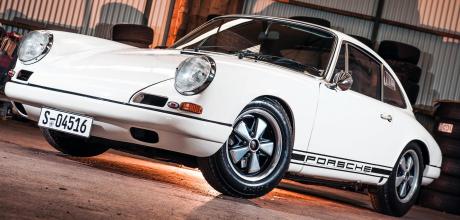1967 Porsche 911R
Belgian 911 enthusiast Frank Hendrickx has many über-rare sporting icons in his collection. He was kind enough to grant Total 911 full access to the first R at Abbeville circuit, France.
Written by Kieron Fennelly
Photographed by Laurens Parsons
Iconic 911 - The lightest ever Porsche 911 produced is also one of the rarest, as we find out

You have to be a determined – not to mention well-heeled – 911 enthusiast to have the 911R in your Porsche collection. However, Frank Hendrickx is no ordinary collector, having spent over a decade tracking down some of these cars. What matters to him is the absolute authenticity of his 911s that requires a commitment bordering on obsession, but the result is the pure delight of being able to appreciate and drive these rare period Porsches. Frank begins by explaining to us how he caught the 911 virus.

That came in 1991, when Frank paid a deposit on the then-recently launched RS 964. He became a total recidivist, and today his collection includes, aside from the car we’re about to introduce, other 911 exotica such as the Ruf CTR, SC RS, and the C4 Leichtbau. But alas, the R is the most special…
The earliest ‘special’ 911 in the collection is the 911 R, a car that was a casebook study in removing weight. The 160bhp S was already proving successful in competition, but technical director Ferdinand Piëch realised that a ground-up racer was required to win at the highest level, so he had the 911 significantly lightened.
The ‘R’, for Rennen (racing), was assembled by coach-builder Karl Bauer, who fitted doors, bonnets and engine covers, as well as bumpers in glass fibre. The windscreen used 4mm-thick glass (instead of 6mm) and perspex replaced the other windows. Aluminium hinges and simplified catches were employed throughout, and steel bulkheads everywhere were drilled to eliminate vital ounces. The interior was stripped, the dash cut back to three instruments and Scheel bucket seats replaced the standard items. The standard suspension was lowered, and the 210bhp engine and gearbox of the 906 racer fitted.
Weighing not much over 800kg, the R proved to be fast and reliable, and achieved a series of international speed records, but it never got beyond the prototype stage, as the Porsche board refused to sanction production of the necessary 500 units to qualify the R forproduction car racing – which was Piëch’s aim. So only 22 of this, the lightest 911 ever made, were built. With no racing category available to them, it took Porsche a couple of years to find customers for the Rs.
What a contrast 40 years on, when these Porsches sell for well into six figures. Hendrickx tracked his car down in California, where documents showed that this was the second R built, and that it was used as the back-up car at the international speed record attempts at Monza in May 1967 before becoming a works racer, being sold when the 911 model went to 2.2 litres. The buyer was an Italian, Dr Daolio, who took the R to Asmara in Eritrea, where he worked, and the 911 R competed extensively in local rallies and street races before going to a Japanese collector when the doctor returned to Italy in 1980. The R saw almost no use for the next 30 years – when Frank acquired it, the clocks showed only 32,000km.
On Abbeville’s smooth tarmac, the R is a delight to drive. The steering is light and very direct, the gear change with its dog leg first requires no effort, and on winter tyres this racing 911 drifts beautifully through tight corners. The engine is amazingly responsive: Frank has weighed the car at 820kg – exactly its ex-factory weight – and the engine delivers 216bhp according to the dynamometer, a power to weight ratio unmatched by naturally aspirated production 911s until the first GT3.
“Porsche is in my blood. My grandfather had a string of early Targas before he bought an RS 2.7 – the first Porsche I ever drove, incidentally – and then one of the first 3.0-litre Turbos… I bought a 911T to restore, but I ran out of money, and all my dad would say was ‘You can have a 911 when you can afford to run one.”
R SPEC
Weight-saving measures on the 911R included drilling holes in the bulkhead and cutting back the dashboard
Lightened shell, with stripped interior and glass fibre body panels
Typ 901/22 engine and gearbox taken from 906 racerOnly 22 ever madeThe Typ 901/22 2.0-litre engine from the 906 was used in the 911R, producing 210bhp
Bought by Hendrickx in California, this R spec was used at an international record attempt at Monza in 1967 and for a while in Eritrea, Africa.


